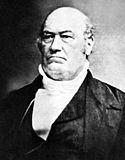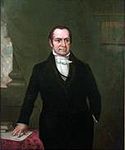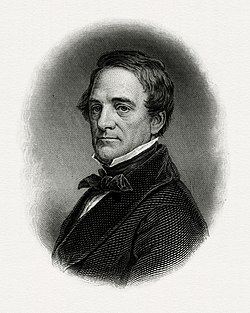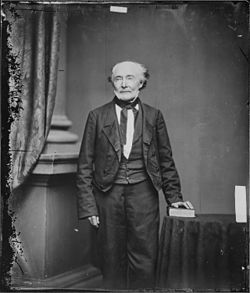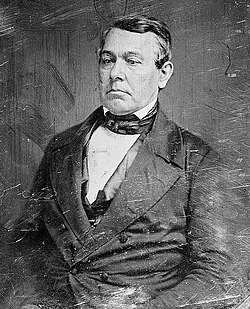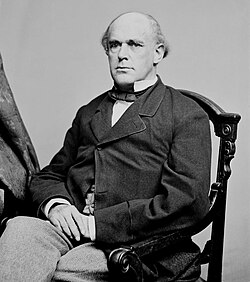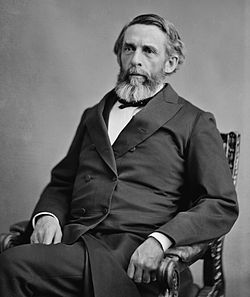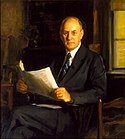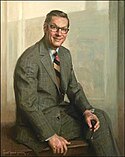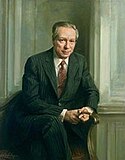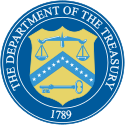No. Portrait Name State of residence Took office Left office President(s) 1 Alexander Hamilton New York September 11, 1789 January 31, 1795 George Washington 2 Oliver Wolcott Jr. Connecticut February 3, 1795 December 31, 1800 John Adams 3 Samuel Dexter Massachusetts January 1, 1801 May 13, 1801 Thomas Jefferson 4 Albert Gallatin Pennsylvania May 14, 1801 February 8, 1814 James Madison 5 George W. Campbell Tennessee February 9, 1814 October 5, 1814 6 Alexander Dallas Pennsylvania October 6, 1814 October 21, 1816 – William Jones Acting [ a] Pennsylvania October 21, 1816 October 22, 1816 7 William H. Crawford Georgia October 22, 1816 March 6, 1825 James Monroe 8 Richard Rush Pennsylvania March 7, 1825 March 5, 1829 John Quincy Adams 9 Samuel D. Ingham Pennsylvania March 6, 1829 June 20, 1831 Andrew Jackson 10 Louis McLane Delaware August 8, 1831 May 28, 1833 11 William J. Duane Pennsylvania May 29, 1833 September 22, 1833 12 Roger B. Taney Maryland September 23, 1833 June 25, 1834 13 Levi Woodbury New Hampshire July 1, 1834 March 3, 1841 Martin Van Buren 14 Thomas Ewing Ohio March 4, 1841 September 11, 1841 William Henry Harrison John Tyler 15 Walter Forward Pennsylvania September 13, 1841 March 1, 1843 16 John Canfield Spencer New York March 8, 1843 May 2, 1844 17 George M. Bibb Kentucky July 4, 1844 March 7, 1845 18 Robert J. Walker Mississippi March 8, 1845 March 5, 1849 James K. Polk 19 William M. Meredith Pennsylvania March 8, 1849 July 22, 1850 Zachary Taylor 20 Thomas Corwin Ohio July 23, 1850 March 6, 1853 Millard Fillmore 21 James Guthrie Kentucky March 7, 1853 March 6, 1857 Franklin Pierce 22 Howell Cobb Georgia March 7, 1857 December 8, 1860 James Buchanan 23 Philip Francis Thomas Maryland December 12, 1860 January 14, 1861 24 John Adams Dix New York January 15, 1861 March 6, 1861 25 Salmon P. Chase Ohio March 7, 1861 June 30, 1864 Abraham Lincoln 26 William P. Fessenden Maine July 5, 1864 March 3, 1865 27 Hugh McCulloch Indiana March 9, 1865 March 3, 1869 Andrew Johnson 28 George S. Boutwell Massachusetts March 12, 1869 March 16, 1873 Ulysses S. Grant 29 William Adams Richardson Massachusetts March 17, 1873 June 3, 1874 30 Benjamin Bristow Kentucky June 4, 1874 June 20, 1876 31 Lot M. Morrill Maine July 7, 1876 March 9, 1877 32 John Sherman Ohio March 10, 1877 March 3, 1881 Rutherford B. Hayes 33 William Windom Minnesota March 8, 1881 November 13, 1881 James A. Garfield Chester A. Arthur 34 Charles J. Folger New York November 14, 1881 September 4, 1884 35 Walter Q. Gresham Indiana September 5, 1884 October 30, 1884 36 Hugh McCulloch Indiana October 31, 1884 March 7, 1885 37 Daniel Manning New York March 8, 1885 March 31, 1887 Grover Cleveland 38 Charles S. Fairchild New York April 1, 1887 March 6, 1889 39 William Windom Minnesota March 7, 1889 January 29, 1891 Benjamin Harrison 40 Charles Foster Ohio February 25, 1891 March 6, 1893 41 John G. Carlisle Kentucky March 7, 1893 March 5, 1897 Grover Cleveland 42 Lyman J. Gage Illinois March 6, 1897 January 31, 1902 William McKinley Theodore Roosevelt 43 L. M. Shaw Iowa February 1, 1902 March 3, 1907 44 George B. Cortelyou New York March 4, 1907 March 7, 1909 45 Franklin MacVeagh Illinois March 8, 1909 March 5, 1913 William Howard Taft 46 William Gibbs McAdoo New York March 6, 1913 December 15, 1918 Woodrow Wilson 47 Carter Glass Virginia December 16, 1918 February 1, 1920 48 David F. Houston Missouri February 2, 1920 March 3, 1921 49 Andrew Mellon Pennsylvania March 4, 1921 February 12, 1932 Warren G. Harding Calvin Coolidge Herbert Hoover 50 Ogden L. Mills New York February 13, 1932 March 4, 1933 51 William H. Woodin New York March 5, 1933 December 31, 1933 Franklin D. Roosevelt 52 Henry Morgenthau Jr. New York January 1, 1934 July 22, 1945 53 Fred M. Vinson Kentucky July 23, 1945 June 23, 1946 Harry S. Truman 54 John Wesley Snyder Missouri June 25, 1946 January 20, 1953 55 George M. Humphrey Ohio January 21, 1953 July 29, 1957 Dwight D. Eisenhower 56 Robert Anderson Connecticut July 29, 1957 January 20, 1961 57 C. Douglas Dillon New Jersey January 21, 1961 April 1, 1965 John F. Kennedy Lyndon B. Johnson 58 Henry H. Fowler Virginia April 1, 1965 December 20, 1968 59 Joseph W. Barr Indiana December 21, 1968 January 20, 1969 60 David Kennedy Utah January 22, 1969 February 10, 1971 Richard Nixon 61 John Connally Texas February 11, 1971 June 12, 1972 62 George Shultz Illinois June 12, 1972 May 8, 1974 63 William E. Simon New Jersey May 8, 1974 January 20, 1977 Gerald Ford 64 W. Michael Blumenthal Michigan January 23, 1977 August 4, 1979 Jimmy Carter 65 G. William Miller Rhode Island August 7, 1979 January 20, 1981 66 Donald Regan New Jersey January 22, 1981 February 1, 1985 Ronald Reagan 67 James Baker Texas February 4, 1985 August 17, 1988 – M. Peter McPherson Acting [ b] Michigan August 17, 1988 September 15, 1988 68 Nicholas F. Brady New Jersey September 15, 1988 January 17, 1993 George H. W. Bush 69 Lloyd Bentsen Texas January 20, 1993 December 22, 1994 Bill Clinton – Frank N. Newman Acting [ b] Massachusetts December 22, 1994 January 11, 1995 70 Robert Rubin New York January 11, 1995 July 2, 1999 71 Lawrence Summers Maryland July 2, 1999 January 20, 2001 72 Paul H. O'Neill Pennsylvania January 20, 2001 December 31, 2002 George W. Bush – Kenneth W. Dam Acting [ b] Illinois December 31, 2002 February 3, 2003 73 John W. Snow Virginia February 3, 2003 June 30, 2006 – Robert M. Kimmitt Acting [ b] Virginia June 30, 2006 July 10, 2006 74 Henry Paulson Illinois July 10, 2006 January 20, 2009 – Stuart A. Levey Acting [ c] Ohio January 20, 2009 January 26, 2009 Barack Obama 75 Timothy Geithner New York January 26, 2009 January 25, 2013 – Neal S. Wolin Acting [ b] Illinois January 25, 2013 February 28, 2013 76 Jack Lew New York February 28, 2013 January 20, 2017 – Adam Szubin Acting [ c] Washington, D.C. January 20, 2017 February 13, 2017 Donald Trump 77 Steven Mnuchin California February 13, 2017 January 20, 2021 – Andy Baukol Acting [ d] Virginia January 20, 2021 January 26, 2021 Joe Biden 78 Janet Yellen California January 26, 2021 January 20, 2025 – David Lebryk Acting [ e] Indiana January 20, 2025 January 28, 2025 Donald Trump 79 Scott Bessent South Carolina January 28, 2025 Incumbent 
















